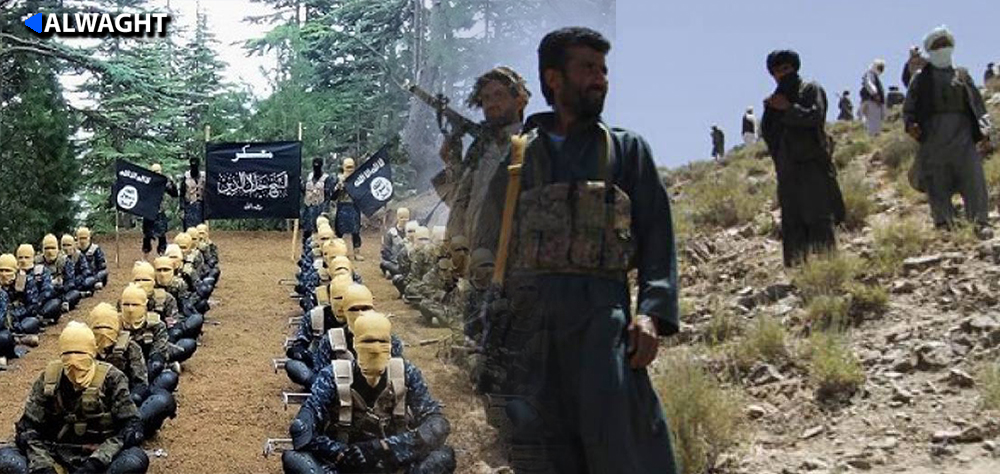Alwaght- In the past weeks, Afghanistan turned into a focal point of international events, with the Taliban militants on the one hand pushing ahead with their campaign to seize more cities and the central government forces on the other hand resisting the attacks despite their losses.
In the meantime, a very important and worrying development for regional and international peace and stability is that the existing climate provides room for the ISIS terrorist group to expand. Indeed, the course of recent developments indicates that the terrorist group may become the third actor in Afghanistan's political and military stages in the near future, despite the Taliban's claim it counters ISIS. With a major part of its power lost regionally, the fundamentalist group can make Afghanistan a setting of its re-emergence.
ISIS seeking revival
Over the past few days, ISIS shored up its presence and activities in Afghanistan’s north, where the country shares borders with Tajikistan, causing severe concerns of home and foreign sides. According to evidence, in Takhar, Sar-e-Pol, and Faryab, ISIS has established fighter amassment and advanced its activities there. Reports emanating from these regions suggest that its militants have committed several crimes against the civilians and security forces.
For example, the takfiri group executed a traffic policeman in its most recent crime in the Dasht-e Abdan district of Kunduz province near the border with Tajikistan. The inhumane act comes while less than a week ago, Afghan media published a report talking about deployment of Jamaat Ansarullah movement of Tajikistan fighters to Badakhshan province's border towns. Further reports say Kuf Ab, Shekay, Nessi, Mayami, and Khahan districts are now under Jamaat fighters' control. With these ISIS efforts to build itself a stronghold in Afghanistan, many experts set off the alarm bells to other Central Asian countries, China, and Russia. All the available facts on the ground indicate that the power vacuum created by the Taliban's clashes with the central government forces has now given a significant breathing space for ISIS to rise in the war-ravaged country. Here is an important question to answer: Is ISIS regaining power independently or there is foreign support for it?
Special US goals in Central Asia
While unavoidably marking defeat of the US war, the scheduled withdrawal from Afghanistan by September's end heralds a new secret American plot to spread terrorism in Central Asia using ISIS.
Washington is trying to provide support to ISIS in northern Afghanistan. In fact, the US is trying to establish ISIS in Tajikistan and then to involve Uzbekistan, Turkmenistan and Kyrgyzstan in the terrorism challenge. This is Washington's ultimate strategy for promoting terrorism and extremism in Central Asia, thereby paving the way for its presence in the region as well as creating a security threat to its rivals.
Here seems to be a deal Washington struck with the Taliban to protect the American geopolitical interests, even if it comes at the expense of the Afghanistan people and regional states' interests. The Biden administration is seeking to transform Central Asia into a threat and insecurity-stricken region and then unveil its solution to alleviate the worries of regional states. On April 23, the US Secretary of State Anthony Blinken hosted a virtual meeting of his counterparts from five Central Asian countries of Kazakhstan, Kyrgyzstan, Tajikistan, Turkmenistan, and Uzbekistan. At the C5+1 meeting, he reiterated the so-called US commitment to their national security and sovereignty. At first place the US may look to be seeking to provide assurances to these five nations, but the fact is that is pursuing a toehold establishment in the region.
Moscow and Beijing at the center of Washington threats
In the new context, the central US strategy on the international stage revolves around "pivot to the East" and specifically China. From the Americans' point of view, Beijing, with its huge investments in the Belt and Road Initiative, much of which is in Central Asian countries, intends to take advantage of the eroding US power to capture the pulse of international trade and the global economy. Therefore, it seems that American strategists, in order to prevent the development of China's economic and political influence, on the one hand, need to establish military bases in Central Asian countries, and on the other hand, seek to promote terrorism on China's borders.
Another target is Russia and its spheres of influence. The Russian officials are now largely concerned about the withdrawal of troops from Afghanistan which is turning into process of transfer of the US forces and bases to Central Asia. Even more so, many political observers see the US withdrawal from Afghanistan as a predetermined scenario to drag Russia into terrorism swamp on its borders.
Senior Russian security officials have repeatedly expressed concern about the escalation of terrorist activity, particularly in Afghanistan and near the border with Tajikistan. They appear to be aware of the American plot to generate security threats for Moscow and have already taken preemptive actions. Understanding the long-term US strategy to dominate the rich resources of the Central Asian and Mediterranean states, the Russians have signed a 50-year deal for presence of their forces on the southern borders of Tajikistan to prevent ISIS from building presence by crossing Afghanistan border into Tajikistan. That is beside Moscow's repeated announcements that it is ready to secure the Tajik border and strengthen border forces to check terrorist fighters from transferring to Tajikistan primarily and then other regional countries in the Russian vicinity.



























